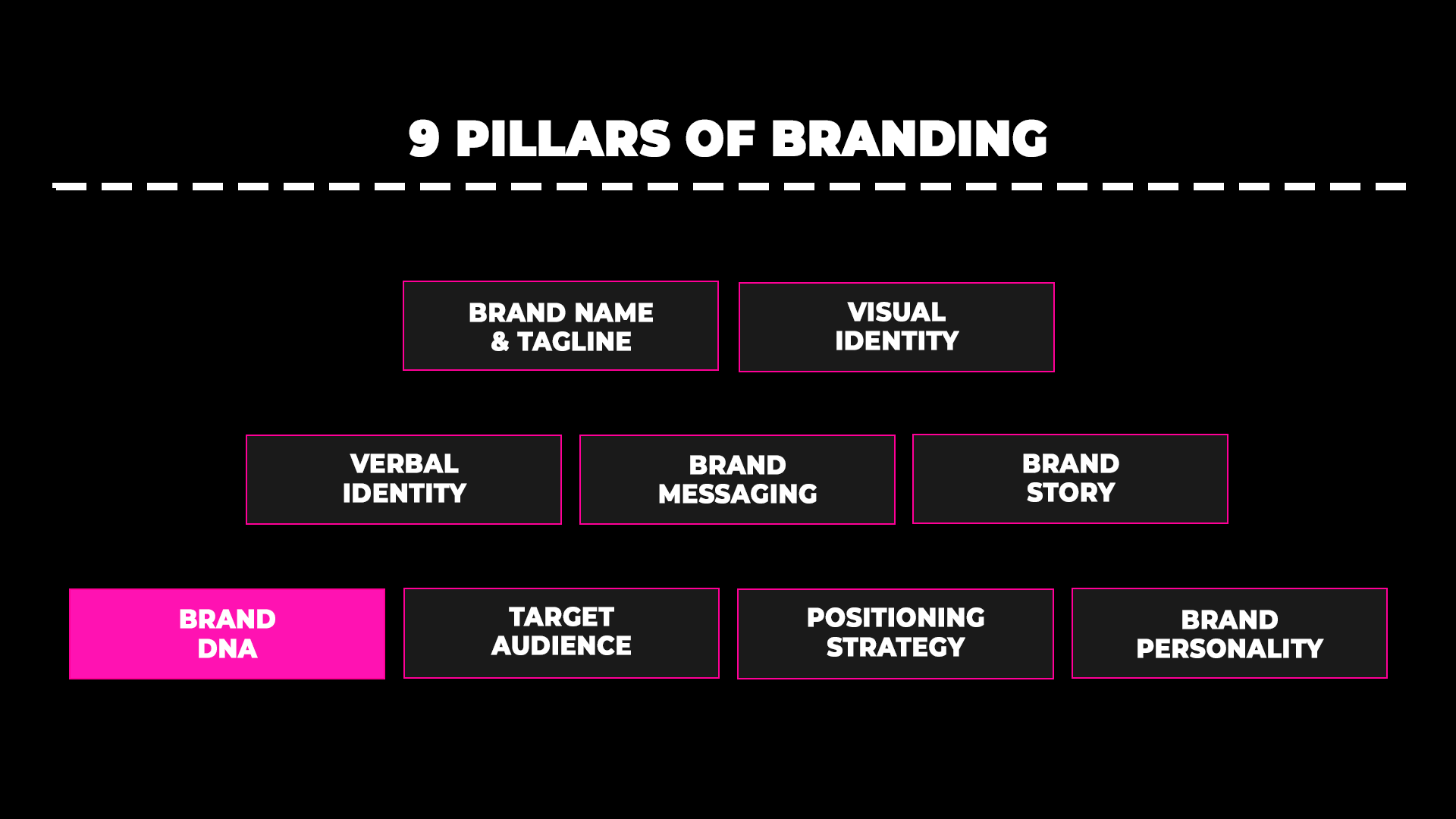Branding is the heartbeat of every successful business.
It’s the magic that transforms a simple idea into a powerful entity.
It’s about creating a unique identity that resonates with your target audience and stands out in the crowded marketplace.
In this guide, we’ll explore the fundamentals of branding 101 and how to build a strategic brand in 2023.
What is Branding?

Branding, in its essence, is the process of creating a unique identity for a product, service, or company.
Branding is about creating a holistic brand image that encapsulates the essence of your business and communicates it effectively to your target audience.
When we talk about branding, we’re talking about creating a distinct and consistent perception in the minds of your customers. It’s about defining who you are as a business and how you want to build a brand to be perceived by the world.
It’s about creating an emotional connection with your customers, building trust, and fostering loyalty.
Branding is the embodiment of your business’s personality. It’s the voice that speaks to your audience when you’re not in the room. It’s the feeling that people get when they interact with your products or services.
It’s the story that unfolds in the minds of your customers when they see your logo or hear your name.
Why is Branding so Important?

Branding is crucial in today’s competitive business landscape.
It’s the tool that allows businesses to stand out in a crowded market, how brands create a memorable impression on consumers, and build customer loyalty.
A strong brand acts as a beacon in the marketplace, guiding your target audience towards your products or services.
It helps you connect with your audience on an emotional level, making your business more than just a provider of goods or services, but a part of your potential customers’ lives.
Branding also plays a vital role in driving business growth.
It increases business value, provides employees with direction and motivation, and makes acquiring new customers easier.
A strong brand can command higher prices for products or services because customers perceive higher value in a well-branded product or service.
PRO Brand Strategy BluePrint
Build Brands Like A Pro Brand Strategist

Brand Strategy vs Brand Identity

Brand strategy and brand identity are two fundamental and important aspects of branding, each playing a unique role in the whole branding strategy process.
Brand strategy is the blueprint that guides your branding efforts.
It outlines your mission, vision, and values, and defines how you communicate your brand to your target audience. It’s your game plan for creating a unique and compelling brand that resonates with your customers.
Your brand strategy should answer questions like:
What is the purpose of your brand?
Who is your target audience?
What are your brand’s core values?
How do you differentiate your brand from competitors?
How do you want your brand to be perceived by your audience?
On the other hand,
Brand identity is the tangible manifestation of your brand strategy.
It’s the collection of all brand elements that you create to portray the right image of your brand to your audience. This includes your logo design, color palette, typography, imagery, packaging, website design, and even the tone of voice in your communication.
Your brand identity is the face of your business. It’s what makes you recognizable and memorable in the minds of your customers.
It’s what sets you apart from your competitors and makes you a brand stand unique.
The 9 Pillars Of A Successful Brand

Explore Brand Strategy
Programs & Tools
Brand DNA
(Purpose, Vision, Mission, Values)

The DNA of your brand is the foundation upon which all other elements are built. It’s the core essence of your brand that guides all your branding efforts.
Your brand’s purpose is the reason why your brand exists beyond just making a profit. It’s the unique value you promise to deliver to your customers.
Your vision is the aspirational future state you envision for your brand. It’s where you see your brand in the future.
Your mission statement is the roadmap that guides your brand towards its vision. It’s what your brand does every day to achieve its vision.
Your values are the guiding principles that define your brand’s culture and behavior. They’re what your brand stands for and believes in.
Target Audience

Your target audience is the specific group of people your brand aims to reach. They’re the people who are most likely to be interested in your products, marketing, brand design or services.
Understanding your target audience is crucial for creating a brand that resonates with them.
It involves identifying their demographics, psychographics, behaviors, needs, and preferences.
The more you understand your target customer base and audience, the better you can tailor your branding efforts to appeal to them.
Positioning Strategy

Your positioning strategy is how you differentiate your brand from other brands in the market.
It’s how you want your target audience to perceive your brand compared to your competitors different brands.
A strong positioning strategy clearly communicates your brand’s unique value proposition, the unique benefits that your brand offers that set it apart from competitors.
It’s about carving out a unique space in the competitive landscape in the market that your brand owns.
Brand Personality

Your brand personality is the human characteristics associated with your brand.
It’s how your brand speaks, behaves, and interacts with your audience.
Your brand personality can be fun, serious, professional, quirky, adventurous, emotional feeling or any other human trait.
It’s what makes your brand relatable and appealing to your target audience.
Verbal Identity

Your verbal identity is the voice of your brand. It’s the tone, style, and language you use in all your brand communications.
Your verbal identity should reflect your brand personality and resonate with your target audience.
It’s how your brand sounds to your audience.
Brand Messaging

Your brand messaging is the underlying value proposition and key messages that your brand communicates to your audience.
It’s what you say about your brand and how you say it.
Your brand messaging should clearly communicate your brand’s unique value, benefits, and reasons to believe.
Brand Story

Your brand story is the narrative that connects your brand with your audience on an emotional level.
It’s the story of who you are, what you do, why you do it, and how you make a difference in your customers’ lives.
A compelling brand story can create a deep emotional connection with your audience and make your brand more memorable.
Brand Name & Tagline

Your brand name and tagline are key elements of your brand identity. They’re often the first things your audience sees or hears about your brand.
A strong brand name is unique, memorable, and meaningful.
It encapsulates the essence of your brand and sets the tone for your brand identity.
Your tagline is great example of a short, catchy phrase that encapsulates your brand’s promise or value proposition.
Visual Identity

Your visual identity is the visual aspect of your brand that your audience can see.
It includes visual languages, your logo, color palette, typography, imagery, and any other visual elements associated with your brand.
Your visual identity should be consistent across all touchpoints and should visually communicate your brand personality and values.
The Branding Process: From Concept to Launch

The branding process is a systematic approach to creating and launching a brand. It involves several stages, each requiring careful planning and execution.
The process begins with understanding your business model, market, and target audience.
This is followed by defining your brand strategy, which includes your brand DNA, brand positioning strategy, and brand personality.
Once your brand strategy is defined, the next step is to create your brand identity. This includes designing your logo, choosing your color palette, secondary fonts, defining your typography, and creating any other visual elements associated with your brand.
After your brand identity is created, the next step in brand recognition is to launch your brand.
This involves introducing your brand to your target audience through various channels such as your website, social media, advertising, PR, and more.
The final stage of the branding process is brand management. This involves monitoring your brand’s performance, managing your brand’s reputation, and continuously refining your brand strategy based on market changes and customer feedback.
Over To You
Branding is not a one-time event; it’s a continuous journey. It’s about consistently delivering on your brand promise, continuously refining your brand strategy based on market changes and customer feedback, and constantly finding new ways to connect with your audience on a deeper level.
It’s about evolving with your audience and the market, and continuously striving to create a brand that resonates with your audience and stands out in the market.
FAQs
1. What are the 4 steps of branding?
The four steps of branding are:
Defining your brand: This involves understanding your business model, identifying your target audience, and defining your brand’s purpose, vision, mission, and values.
Developing your brand identity: This involves creating the visual and verbal elements that represent your brand, such as your logo, color scheme and palette, typography, brand voice, and brand messaging.
Launching your brand: This involves introducing your brand to your target audience through various channels such as your website, your social media accounts, advertising, PR, and more.
Managing your brand: This involves monitoring your brand’s performance, managing your brand’s reputation, and continuously refining your brand strategy based on market changes and customer feedback.
2. What are the 7 stages of the branding process?
The seven stages of the branding process are:
Market Research: Understanding your market, competitors, and target audience.
Brand Strategy: Defining your brand’s purpose, vision, mission, values, and positioning.
Brand Identity: Creating your brand’s visual and verbal identity.
Brand Messaging: Defining the key messages that your brand will communicate to your audience.
Brand Launch: Introducing your brand to your first target market and audience.
Brand Promotion: Promoting your brand through various marketing channels.
Brand Management: Monitoring and managing your brand’s performance and reputation.
3. What are the four 4 types of branding strategies?
The four types of branding strategies are:
Corporate Branding: This involves creating a strong brand for the entire corporation that reflects the company’s vision, mission, and values.
Product Branding: This involves creating a unique brand for each product or service offered by the company.
Personal Branding: This involves creating a brand around an individual, often the founder or CEO of the company.
Geographical Branding: This involves creating a brand that is associated with a specific geographical location.
4. What are the three C’s of branding?
The three C’s of branding are:
Clarity: Your brand should clearly communicate who you are, what you do, and what you stand for. It should be easy for your audience to understand what your brand is all about.
Consistency: Your brand should be consistent across all touchpoints. This includes your visual identity, brand messaging, brand voice, and customer experience.
Connection: Your brand’s voice should connect with your audience on an emotional level. It should resonate with your audience’s needs, desires, and values.
On-Demand Digital Program
Brand Master Secrets
Make the transition from hired-gun to highly valued brand strategist in less than 30 days. The systems, frameworks and tools inside this comprehensive program are all you need to level up.









